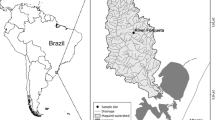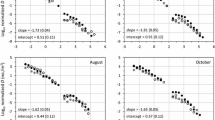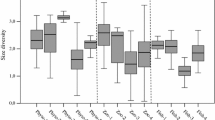Abstract
Even after more than a century of research, the processes underlying species abundance distribution patterns are controversial. Here, we gathered abundance and size (standard length) data of fish species in 54 streams in the Midwest of Brazil to test whether subordinate species abundances (i.e., any species that is not dominant in a community) in each stream are correlated with the absolute size difference between dominant and subordinate species. A negative relationship between these variables would suggest a predominant role of environmental filtering because those species that differ more from the dominant species (the one with the optimum trait value) would become progressively less abundant. On the other hand, a positive relationship would suggest a limit to the similarity as the abundances of subordinate species that differ more from the dominant species would increase. Our results clearly indicated that subordinate species were those that most differed from the dominant species in terms of size. In addition, we found that the subordinate species were larger than the dominant species. Taken together, we infer that environmental filters favoring small body sizes (e.g., shallow water depth and scarcity of large shelters) are the main processes determining species abundance distributions in the streams we studied.





Similar content being viewed by others
Data availability
The datasets of this study are available upon request.
Code availability
Not applicable.
References
Bates, B., M. Maechler, B. M. Bolker & S. C. Walker, 2015. Fitting linear mixed-effects models using lme4. Journal of Statistical Software 67: 1–48.
Blackburn, T. M. & K. J. Gaston, 1997. A critical assessment of the form of the interspecific relationship between abundance and body size in animals. The Journal of Animal Ecology 66: 233.
Borenstein, M., L. V. Hedges, J. P. T. Higgins & H. R. Rothstein, 2009. Introduction to Meta-Analysis, Wiley, Chichester:
Bower, L. M. & K. O. Winemiller, 2019a. Fish assemblage convergence along stream environmental gradients: an intercontinental analysis. Ecography 42: 1691–1702.
Bower, L. M. & K. O. Winemiller, 2019b. Intercontinental trends in functional and phylogenetic structure of stream fish assemblages. Ecology and Evolution 9: 13862–13876.
Brown, B. L. & C. M. Swan, 2010. Dendritic network structure constrains metacommunity properties in riverine ecosystems. Journal of Animal Ecology 79: 571–580.
Brown, J. H., J. F. Gillooly, A. P. Allen, V. M. Savage & G. B. West, 2004. Toward a metabolic theory of ecology. Ecology 85: 1771–1789.
Carlson, S. M., A. P. Hendry & B. H. Letcher, 2004. Natural selection acting on body size, growth rate and compensatory growth: an empirical test in a wild trout population. Evolutionary Ecology Research 6: 955–973.
Carlson, S. M., E. M. Olsen & L. A. Vøllestad, 2008. Seasonal mortality and the effect of body size: a review and an empirical test using individual data on brown trout. Functional Ecology 22: 663–673.
Damuth, J., 1981. Population density and body size in mammals. Nature 290: 699–700.
Erős, T., P. Takács, A. Specziár, D. Schmera & P. Sály, 2017. Effect of landscape context on fish metacommunity structuring in stream networks. Freshwater Biology 62: 215–228.
Ferreira, F. & M. Petrere-Jr, 2008. Comments about some species abundance patterns: classic, neutral, and niche partitioning models. Brazilian Journal of Biology 68: 1003–1012.
Ford, B. M. & J. D. Roberts, 2020. Functional traits reveal the presence and nature of multiple processes in the assembly of marine fish communities. Oecologia 192: 143–154.
Fricke, R., W. N. Eschmeyer, & R. Van der Laan, 2019. Eschmeyer Catalog of Fishes: genera, species, references.
Froese, R., & D. Pauly, 2019. FishBase. version (04/2019). www.fishbase.org.
Harvey, B. C. & A. J. Stewart, 1991. Fish size and habitat depth relationships in headwater streams. Oecologia 87: 336–342.
Hechinger, R. F., K. D. Lafferty, A. P. Dobson, J. H. Brown & A. M. Kuris, 2011. A common scaling rule for abundance, energetics, and production of parasitic and free-living species. Science 333: 445–448.
Henriques-Silva, R., M. Logez, N. Reynaud, P. A. Tedesco, S. Brosse, S. R. Januchowski-Hartley, T. Oberdorff & C. Argillier, 2019. A comprehensive examination of the network position hypothesis across multiple river metacommunities. Ecography 42: 284–294.
Hidasi-Neto, J., L. M. Bini, T. Siqueira & M. V. Cianciaruso, 2020. Ecological similarity explains species abundance distribution of small mammal communities. Acta Oecol 102: 103502.
Hitt, N. P. & P. L. Angermeier, 2008. River-stream connectivity affects fish bioassessment performance. Environmental Management 42: 132–150.
Hubbell, S. P., 2001. The unified neutral theory of biodiversity and biogeography, Princeton University Press, New Jersey:
Ilha, P., L. Schiesari, F. I. Yanagawa, K. Jankowski & C. A. Navas, 2018. Deforestation and stream warming affect body size of Amazonian fishes. PLoS ONE 13: e0196560.
Isaac, N. J. B., D. Storch & C. Carbone, 2011. Taxonomic variation in size–density relationships challenges the notion of energy equivalence. Biology Letters 7: 615–618.
Klipel, J., R. S. Bergamin, G. D. D. S. Seger, M. B. Carlucci & S. C. Müller, 2021. Plant functional traits explain species abundance patterns and strategies shifts among saplings and adult trees in Araucaria forests. Austral Ecology 46: 1084–1096.
Koricheva, J. & J. Gurevitch, 2014. Uses and misuses of meta-analysis in plant ecology. Journal of Ecology 102: 828–844.
Larsen, S., L. Comte, A. Filipa Filipe, M. Fortin, C. Jacquet, R. Ryser, P. A. Tedesco, U. Brose, T. Erős, X. Giam, K. Irving, A. Ruhi, S. Sharma & J. D. Olden, 2021. The geography of metapopulation synchrony in dendritic river networks. Ecology Letters 24: 791–801.
MacArthur, R. H., 1957. On the relative abundance of bird species. Proceedings of the National Academy of Sciences 43: 293–295.
MacArthur, R. H. & R. Levins, 1967. The limiting similarity, convergence, and divergence of coexisting species. The American Naturalist 101: 377–385.
Magurran, A. E., 2005. Species abundance distributions: pattern or process? Functional Ecology 19: 177–181.
Mason, N. W. H., C. Lanoiselée, D. Mouillot, J. B. Wilson & C. Argillier, 2008. Does niche overlap control relative abundance in French lacustrine fish communities? A new method incorporating functional traits. Journal of Animal Ecology 77: 661–669.
Matthews, T. J. & R. J. Whittaker, 2015. On the species abundance distribution in applied ecology and biodiversity management. Journal of Applied Ecology 52: 443–454.
Matthews, W. J., 1998. Patterns in Freshwater Fish Ecology, Springer, Boston:
McGill, B. J., 2003. Does mother nature really prefer rare species or are log-left-skewed SADs a sampling artefact? Ecology Letters 6: 766–773.
McGill, B. J., B. A. Maurer & M. D. Weiser, 2006. Empirical evaluation of neutral theory. Ecology 87: 1411–1423.
McGill, B. J., R. S. Etienne, J. S. Gray, D. Alonso, M. J. Anderson, H. K. Benecha, M. Dornelas, B. J. Enquist, J. L. Green, F. He, A. H. Hurlbert, A. E. Magurran, P. A. Marquet, B. A. Maurer, A. Ostling, C. U. Soykan, K. I. Ugland & E. P. White, 2007. Species abundance distributions: moving beyond single prediction theories to integration within an ecological framework. Ecology Letters 10: 995–1015.
Mouchet, M. A., S. Villéger, N. W. H. Mason & D. Mouillot, 2010. Functional diversity measures: an overview of their redundancy and their ability to discriminate community assembly rules. Functional Ecology 24: 867–876.
Mouillot, D., N. W. H. Mason & J. B. Wilson, 2007. Is the abundance of species determined by their functional traits? A new method with a test using plant communities. Oecologia 152: 729–737.
Murray, B. R., B. L. Rice, D. A. Keith, P. J. Myerscough, J. Howell, A. G. Floyd, K. Mills & M. Westoby, 1999. Species in the tail of rank-abundance curves. Ecology 80: 1806.
Oliveira, F. J. M., D. P. Lima-Junior & L. M. Bini, 2020. Current environmental conditions are weak predictors of fish community structure compared to community structure of the previous year. Aquatic Ecology 54: 729–740.
Peters, R. H., 1983. The ecological implications of body size, Vol. 2. Cambridge University Press, New York:
Pinheiro, J., D. Bates, S. DebRoy, D. Sakar, & R. C. Team, 2018. nlme: Linear and Nonlinear Mixed Effects Models. R package version 3.
Power, M. E., 1984. Depth distributions of armored catfish: predator-induced resource avoidance? Ecology 65: 523–528.
R Core Team, 2021. R: a Language and environment for statistical computing. Vienna, Austria, http://www.r-project.org/.
Reis, R. E., S. O. Kullander, & C. J. Ferraris, 2003. Check List of the freshwater fishes of South and Central America. EDIPUCRS. Porto Alegre, RS.
Schmera, D., D. Árva, P. Boda, E. Bódis, Á. Bolgovics, G. Borics, A. Csercsa, C. Deák, E. Á. Krasznai, B. A. Lukács, P. Mauchart, A. Móra, P. Sály, A. Specziár, K. Süveges, I. Szivák, P. Takács, M. Tóth, G. Várbíró, A. E. Vojtkó & T. Erős, 2017. Does isolation influence the relative role of environmental and dispersal-related processes in stream networks? An empirical test of the network position hypothesis using multiple taxa. Freshwater Biology 63: 74–85.
Sugihara, G., L.-F. Bersier, T. R. E. Southwood, S. L. Pimm & R. M. May, 2003. Predicted correspondence between species abundances and dendrograms of niche similarities. Proceedings of the National Academy of Sciences 100: 5246–5251.
Thornbrugh, D. J. & K. B. Gido, 2010. Influence of spatial positioning within stream networks on fish assemblage structure in the Kansas River basin, USA. Canadian Journal of Fisheries and Aquatic Sciences 67: 596–596.
Tokeshi, M., 1993. Species abundance patterns and community structure. Advances in Ecological Research 24: 111–186.
Ueida, V. S. & R. M. C. Castro, 1999. Coleta e fixação de peixes de riacho. In Caramaschi, E. P., R. Mazzoni & P. R. Peres-Neto (eds), Ecologia de peixes de riachos Oecologia Brasiliensis, Rio de Janeiro: 1–22.
Umaña, M. N., C. Zhang, M. Cao, L. Lin & N. G. Swenson, 2015. Commonness, rarity, and intraspecific variation in traits and performance in tropical tree seedlings. Ecology Letters 18: 1329–1337.
Venere, P. C. & V. Garutti, 2011. Peixes do Cerrado: Parque Estadual da Serra Azul, Rio Araguaia, MT, RiMa, São Carlos:
Viechtbauer, W., 2010. Conducting meta-analyses in R with the metafor Package. Journal of Statistical Software 36: 1–48.
White, E. P., S. K. M. Ernest, A. J. Kerkhoff & B. J. Enquist, 2007. Relationships between body size and abundance in ecology. Trends in Ecology & Evolution 22: 323–330.
Wilson, A. J., J. A. Hutchings & M. M. Ferguson, 2003. Selective and genetic constraints on the evolution of body size in a stream-dwelling salmonid fish. Journal of Evolutionary Biology 16: 584–594.
Winemiller, K. O., 1991. Ecomorphological diversification in lowland freshwater fish assemblages from five biotic regions. Ecological Monographs 61: 343–365.
Zuur, A. F., E. N. Ieno, N. Walker, A. A. Saveliev & G. M. Smith, 2009. Mixed effects models and extensions in ecology with R, Springer, New York:
Acknowledgements
We thank two anonymous reviewers for their valuable comments. FJMO was supported by a fellowship from the Coordenação de Aperfeiçoamento de Pessoal de Nível Superior (CAPES). We are grateful to the Fundação de Amparo à Pesquisa do Estado de Mato Grosso (FAPEMAT) for the financial support (227925/2015). DPLJ and LMB are supported by the Conselho Nacional de Desenvolvimento Científico e Tecnológico (CNPq) (448823/2014-4 and 308974/2020-4, respectively). This paper was developed in the context of National Institutes for Science and Technology (INCT) in Ecology, Evolution, and Biodiversity Conservation supported by MCTIC/CNPq (465610/2014‐5) and FAPEG (201810267000023).
Funding
Fundação de Amparo à Pesquisa do Estado de Mato Grosso (FAPEMAT Notice 002/2015, Process 155509/2015) and Coordenação de Aperfeiçoamento de Pessoal de Nível Superior (Finance Code 001). This work was also developed in the context of the National Institutes for Science and Technology (INCT) in Ecology, Evolution and Biodiversity Conservation, supported by MCTIC/CNPq (proc. 465610/20145) and FAPEG.
Author information
Authors and Affiliations
Contributions
LMB and FJMO conceived and designed the study. FJMO and DPLJr performed data collection in the field. FJMO and LMB performed the analyses and wrote the manuscript with the support of DPLJr. FJMO, DPLJr, and LMB reviewed the manuscript and approved the publication.
Corresponding author
Ethics declarations
Conflict of interest
The authors declare that they have no conflict of interest.
Ethical approval
Animal Use Ethics Committee of the Federal University of Mato Grosso (CEUA/UFMT – Nº 23108.152116).
Additional information
Handling Editor: Fernando M. Pelicice
Publisher's Note
Springer Nature remains neutral with regard to jurisdictional claims in published maps and institutional affiliations.
Supplementary Information
Below is the link to the electronic supplementary material.
Rights and permissions
About this article
Cite this article
Oliveira, F.J.M., Lima Junior, D.P. & Bini, L.M. Body size explains patterns of fish dominance in streams. Hydrobiologia 849, 2241–2251 (2022). https://doi.org/10.1007/s10750-022-04860-6
Received:
Revised:
Accepted:
Published:
Issue Date:
DOI: https://doi.org/10.1007/s10750-022-04860-6




